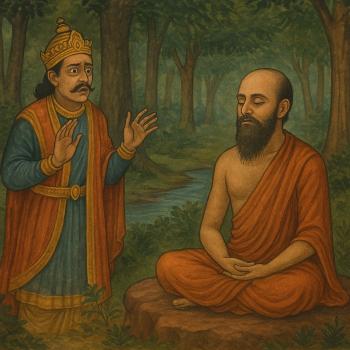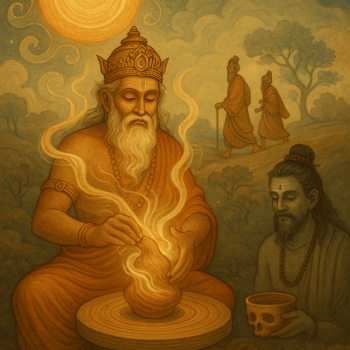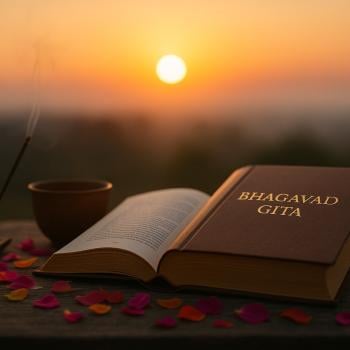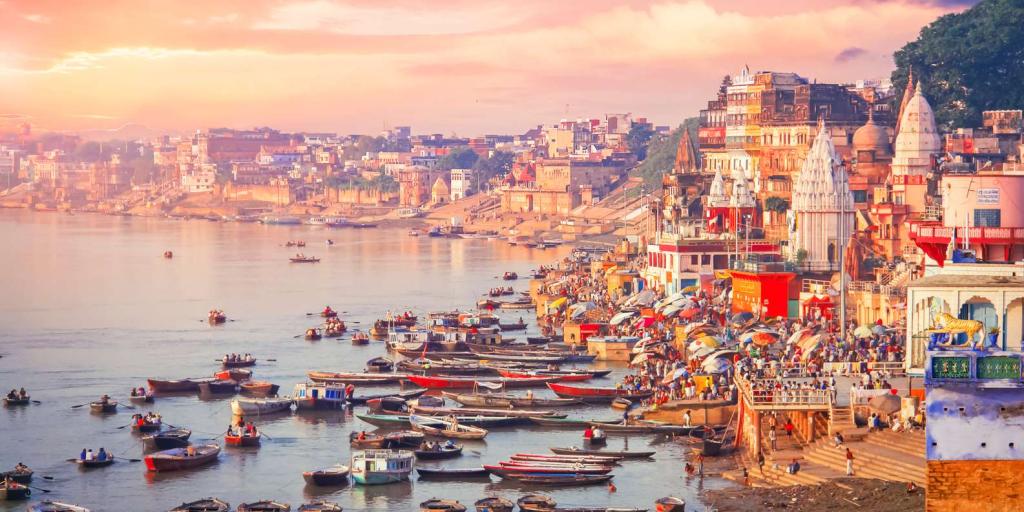
India is called the holy land, whose sacredness is testified to by the cult of the rivers and mountains where pilgrims worship their gods. It has fascinated people from all over the world who seek wisdom, yoga, and the ultimate goal of salvation. The timeless traditions and sacred sites across this vast country offer a deep connection to ancient philosophies and practices. Among these sacred destinations, Varanasi stands out as a beacon of spiritual energy and enlightenment.
I have always been deeply connected to my spiritual roots, which has fuelled my fascination with our sacred scriptures and the immense wisdom they hold. I have long dreamt of visiting the many pilgrimage sites across India to immerse myself in our rich culture and traditions.
When the opportunity finally came, I didn’t know where to begin. Seeking guidance, I turned to my Acharya ji, who suggested starting my journey in Varanasi.
I asked, “Why Varanasi?” He replied, “Varanasi, the spiritual capital of India, and one of the holiest cities for Hindus, offers a deep dive into Hindu culture, rituals, and philosophy.”
As I stepped into this ancient city, I was immediately captivated by its timeless charm and profound energy.
The Mesmerizing First Glimpse
The moment I arrived; the sight of the sacred Ganges River took my breath away. The ghats, bustling with life and devotion, seemed to hum with a divine energy. Watching people perform their morning rituals at the riverbank—bathing in the holy waters, offering prayers, and chanting mantras—made me feel part of something eternal and sacred. The serenity of the Ganges flowing amidst this activity was both calming and awe-inspiring.
Sunrise Boat Ride
Rising early for a boat ride along the Ganges was one of the highlights of my visit. At dawn, the ghats come alive with activity. People arrive to perform morning prayers, practice yoga, and bathe in the sacred waters. Monks wash themselves before sunrise, while others collect holy water to take back to family members.
Despite its spiritual significance, the Ganges is also one of the world’s most polluted rivers. Sewage and industrial waste are common pollutants, but this does not deter the faith of those who see the river as divine.
The view of the rising sun casting its golden glow over the river was unforgettable. Hundreds of seagulls flew overhead, and boats bustled with domestic and international tourists. It was a magical experience that encapsulated the essence of Varanasi.
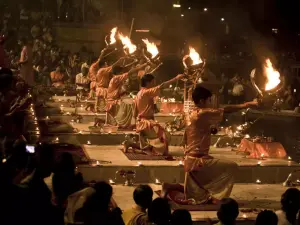
Dashashwamedh Ghat and Ganga Aarti
At the Dashashwamedh Ghat, I witnessed the Ganga Aarti, an unforgettable ritual. The priests performed synchronized movements with glowing lamps, releasing the fragrance of incense into the air, while chants resonated deeply in the atmosphere. The combination of these elements created a captivating and profoundly spiritual experience. As I stood among the crowd, watching the flames illuminate the evening sky, I felt a transcendent connection to the divine, as if I had stepped into a timeless moment.
Experiencing the ceremony from a boat provided an enchanting perspective of the rituals. However, standing close to the stage revealed intricate details and heightened the sense of participation. Lighting a lotus flower candle and letting it drift on the Ganges added a deeply personal and symbolic touch, leaving me with a feeling of serenity and gratitude.
Exploring the Streets and Temples
The narrow alleyways of Varanasi are a treasure trove of sights and sounds. Tiny shops, street food vendors, and wandering cows add to the charm. Over 23,000 temples dot the city, including the famous Kashi Vishwanath Temple and the welcoming Tulsi Manas Temple. Each street corner presents photographic opportunities and a chance to immerse yourself in local life.
Kashi Vishwanath Temple: A Divine Encounter
The visit to the Kashi Vishwanath Temple was truly an unforgettable experience. As I walked through the crowded yet sacred alleys to reach the temple, a sense of anticipation built within me. The temple’s aura was powerful, and standing before the lingam, I felt an overwhelming sense of peace and gratitude. It was as if Lord Shiva himself was present, blessing all those who came to seek him.
The Kashi Vishwanath Temple, often referred to as the Golden Temple, is one of the most renowned temples in Varanasi. Dedicated to Lord Shiva, it was constructed in 1780 by Maharani Ahilyabai Holkar of Indore, the Maratha monarch. This temple holds immense significance in Hinduism as one of the twelve Jyotirlinga temples, where Shiva is believed to have manifested as a column of light. Situated on the western bank of the sacred Ganges River, the temple stands in Varanasi’s Vishwanath Gali and has been a revered site for centuries.
Known as Vishwanatha or Vishweshwara, meaning “Lord of the Universe,” Shiva has been worshiped at this temple as a central figure of devotion. Pilgrims believe that visiting the Kashi Vishwanath Temple and performing ablutions in the Ganges are essential steps on the path to moksha (liberation). Thousands of devotees visit the temple daily, and the numbers swell dramatically during Mahashivaratri, when a grand procession takes place from the Mahamrityunjaya Temple to the Kashi Vishwanath Temple.
Historically, the famous Mughal emperor Akbar permitted the construction of the temple. However, it was later destroyed by Aurangzeb, the sixth Mughal emperor. The temple’s architecture reflects a unique blend of Hindu and Islamic styles, symbolizing the layers of history it has endured. Despite these historical challenges, the temple remains a profound spiritual and cultural landmark, drawing countless visitors from around the world.
The Burning Ghats
Manikarnika Ghat and Harishchandra Ghat are the only two burning ghats in Varanasi, where cremations take place publicly throughout the day and night. Of the two, Manikarnika Ghat holds the highest sanctity, witnessing approximately 100 cremations daily. Bodies are carried on stretchers by family members, dipped into the sacred Ganges to cleanse sins, and then placed on large wood pyres to burn for about three hours. The flames at Manikarnika Ghat have been burning continuously for over 3,500 years and are regarded as sacred.
Initially, witnessing these rituals was overwhelming, but ultimately, it was a deeply peaceful experience. In Varanasi, death is not seen as a taboo but rather as a celebration of life’s journey and its culmination in liberation (moksha). Observing this intimate ritual was a profound privilege that offered unique insights into the Hindu perspective on life and death.
Lessons from the Ghats
Walking along the Ghats, especially Manikarnika Ghat, revealed a profound truth about the cycle of life and death. Watching the cremation ceremonies served as a stark reminder of the transient nature of life and the ultimate goal of liberation. The acceptance, peace, and reverence surrounding these rituals taught me to view life and death as integral parts of the same divine cycle, inspiring a deeper understanding of existence and the spiritual pursuit of moksha.
Sadhus of Varanasi
Varanasi is home to numerous sadhus, or holy men, who renounce worldly possessions and dedicate their lives to spirituality. They often wear orange robes and engage in meditation and yoga. Some cover themselves in ash, while others lead more extreme lifestyles, such as the Naga sadhus, who worship Shiva and cover themselves in ashes of the dead.
Interacting with these spiritual practitioners offered a unique glimpse into their ascetic lives and unwavering devotion.
Varanasi isn’t just a city; it’s a living, breathing tapestry of culture, spirituality, and history. From the ancient ghats to the bustling streets and profound rituals, every moment in Varanasi is an opportunity for reflection and connection. Whether you’re seeking spiritual insight or a deeper understanding of Indian culture, Varanasi offers experiences that will leave an indelible mark on your soul.




